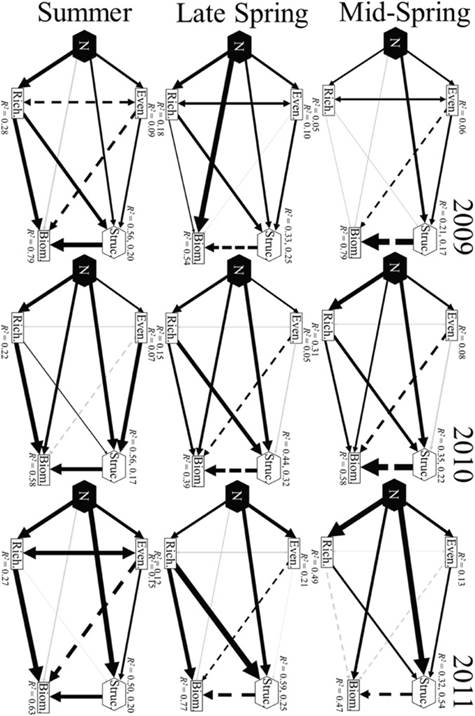

人类工农业活动的增加,导致越来越多的氮素排放到大气并沉降在陆地生态系统表面。氮沉降的增加也成为影响生态系统植物群落结构和功能的重要全球变化因子。干旱区约占全球陆地面积的1/3,由于土壤普遍缺乏氮素,对氮沉降的增加响应尤为敏感。当前,关于氮沉降对荒漠生态系统植物群落影响的研究报道较少。但荒漠地区大量存在的一年生植物为揭示荒漠植物在年际间如何响应氮沉降的增加提供了理想的研究材料。
近期,中国科学院新疆生态与地理研究所研究员张元明团队以准噶尔荒漠为研究区,设定了长期氮沉降模拟增加样地,开展了连续3年的观测实验,研究荒漠草本植物群落对氮增加的响应。研究表明:1)植物丰富度、均匀度、密度和生物量等指标对氮的响应既具有浓度依赖性,又具有季节依赖性,大部分指标随着时间的增加效应变得更加明显。2)氮能够降低物种丰富度,尤其是在高浓度氮增加下,物种数量能够在3年之内减少一半。均匀度和密度在2年之内响应较小,在第3年负效应则开始显现。3)低浓度的氮能够增加生物量,但是随着年限增加,这种效应可能消失,而高浓度的氮具有抑制作用。4)所有的指标之间相互联系,具有级联效应,即生物量对氮素增加的响应受到丰富度、均度及其它群落结构变化的影响,而并不仅是直接受氮素的作用。总体来讲,氮沉降与群落属性关系并不仅仅随季节变化,同时也随时间变化具有一个累积效应,但这种时间上的变化与季节和年际的环境条件不相关。以上研究成果对深入理解氮沉降对荒漠生态系统结构与功能的影响具有重要意义。
相关研究成果发表在Science of The Total Environment上,副研究员周晓兵为第一作者,张元明为通讯作者。该研究得到了国家重点基础研究发展计划、国家自然科学基金等的资助。(来源:中国科学院新疆生态与地理研究所)
Chronic nitrogen addition induces a cascade of plant community responses with both seasonal and progressive dynamics
Abstract Short-lived herbaceous plants provide a useful model to rapidly reveal how multiple generations of plants in natural plant communities of sensitive desert ecosystems will be affected by N deposition. We monitored dynamic responses of community structure, richness, evenness, density and biomass of herbaceous plants to experimental N addition (2:1 NH4+:NO3− added at 0, 0.5, 1, 3, 6 and 24 g N m− 2 a− 1) in three seasons in each of three years in the Gurbantunggut desert, a typical temperate desert of central Asia. We found clear rate-dependent and season-dependent effects of N deposition on each of these variables, in most cases becoming more obvious through time. N addition reduced plant richness, leading to a loss of about half of the species after three generations in the highest N application level. Evenness and density were relatively insensitive to all but the greatest levels of N addition for two generations, but negative effects emerged in the third generation. Biomass, both above and below ground, was non-linearly affected by N deposition. Low and intermediate levels of N deposition often increased biomass, whereas the highest level suppressed biomass. Stimulatory effects of intermediate N addition disappeared in the third generation. All of these responses are strongly interrelated in a cascade of changes. Notably, changes in biomass due to N deposition were mediated by declines in richness and evenness, and other changes in community structure, rather than solely being the direct outcome of release from limitation. The interrelationships between N deposition and the different plant community attributes change not only seasonally, but also progressively change through time. These temporal changes appear to be largely independent of interannual or seasonal climatic conditions.
原文链接:http://www.sciencedirect.com/science/article/pii/S0048969718300251



